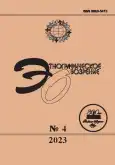Navayana of Bhimrao Ramji Ambedkar: buddhist modernism as an instrument of social transformation
- Autores: Shcherbak M.B1
-
Afiliações:
- Institute of Ethnology and Anthropology, Russian Academy of Sciences
- Edição: Nº 4 (2023)
- Páginas: 94-107
- Seção: Articles
- URL: https://journals.rcsi.science/0869-5415/article/view/142111
- DOI: https://doi.org/10.31857/S0869541523040061
- EDN: https://elibrary.ru/HJGURG
- ID: 142111
Citar
Texto integral
Resumo
Palavras-chave
Sobre autores
M. Shcherbak
Institute of Ethnology and Anthropology, Russian Academy of Sciences
Email: mariam.net@mail.ru
Moscow, Russia
Bibliografia
- Агаджанян А.С. Буддийский путь в ХХ веке. М.: Восточная литература, 1993.
- Бочковская А.В. Прах памяти и единения // Смерть в Махараштре. Воображение, восприятие, воплощение / Ред. И.П. Глушкова. М.: Наталис, 2012. С. 755-763.
- Успенская Е.Н. Антропология индийской касты. СПб.: Наука, 2010.
- Beltz J. Mahar, Bouddhiste et Dalit: Conversion religieuse et émancipation sociopolitique dans l'Inde des caste. Bruxelles: Peter Lang, 2001.
- Enthoven R.E. The Tribes and Castes of Bombay. Bombay: Government Printing Press, 1920.
- Kloppenborg R. The Anagarika Dharmapala (1864-1933) and the Puritan Pattern // Nederlands Theologisch Tijdschrift. 1992. Vol. 46. No. 4. P. 277-283.
- Maude A., Basham R. Army Service and Social Mobility: The Mahars of the Bombey Presidency with Comparison with the Bene-Israeli and Black Americans. PhD diss., The University of British Columbia, 1985.
- Omvedt G. Buddhism in India: Challenging Brahmanism and the Caste. New Dehli: Sage Publication, 2003.
- Padole V.S., Rajani K.R. The Mahars: A Study of Their Religion and Socio-Economic Life // International Journal of Humanities and Social Science Research. 2019. Vol. 5 (2): P. 39-45.
- Robertson A. The Mahar Folk: A Study of Untouchables in Maharashtra. Calcutta: YMCA Publishing House, 1938.
- Russel R.V., Hira Lal. The Tribes and Castes of the Central Provinces of India. Delhi: Cosmos Publications, 1975.
- Singh K.S. Population of India: Maharashtra. Vol. 30. Pt. II. Mumbai: Popular Prakashan, 2004.
- Singh U. Exile and Return: The Reinvention of Buddhism and Buddhist Sites in Modern India // South Asian Studies. 2010. Vol. 26. No. 2. P. 193-217.
- Tartakov G. B.R. Ambedkar and Navayana Diksha // Religious Conversion in India: Modes, Motivations, Meanings / Eds. R. Robinson, S. Clarke. Oxford: Oxford University Press, 2007. P. 193-215.
- Teltumbde A. Dalits: Past, Present and Future. N.Y.: Routledge, 2017.
- Vetschera T.P. The Mahars: A Study of Their Culture, Religion and Socio-Economic Life. New Dehli: Inter Cultural Publication, 1994.
- Zelliot E. Ambedkar's Life and His Navayana Buddhism // Routlege Handbook of Contemporary India / Ed. K.A. Jacobson. N.Y.: Routlege, 2016. P. 361-371.
Arquivos suplementares









